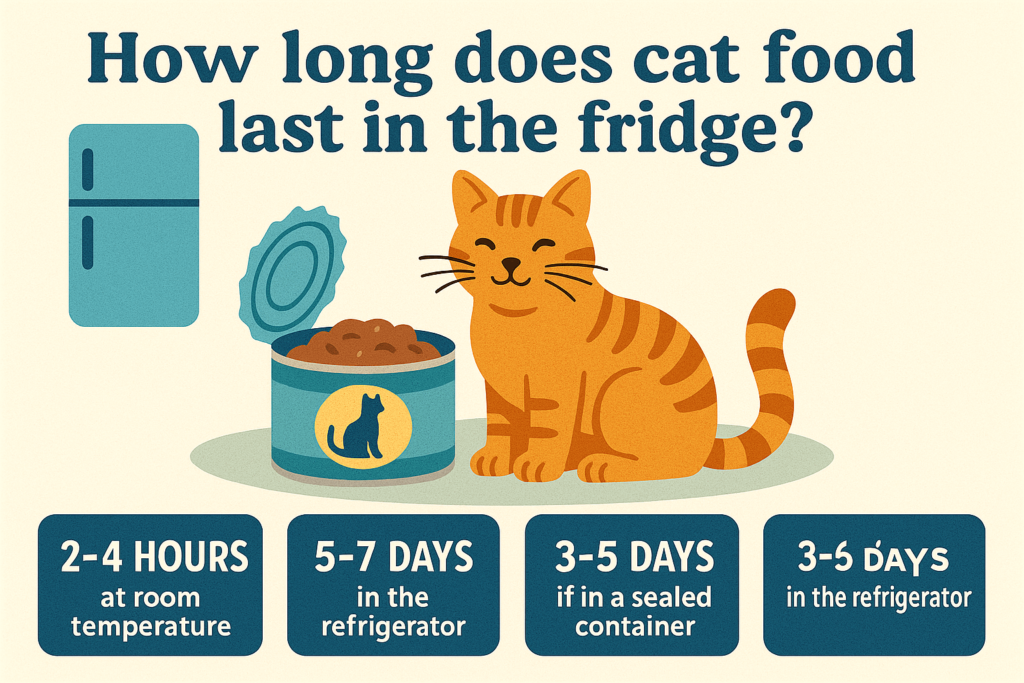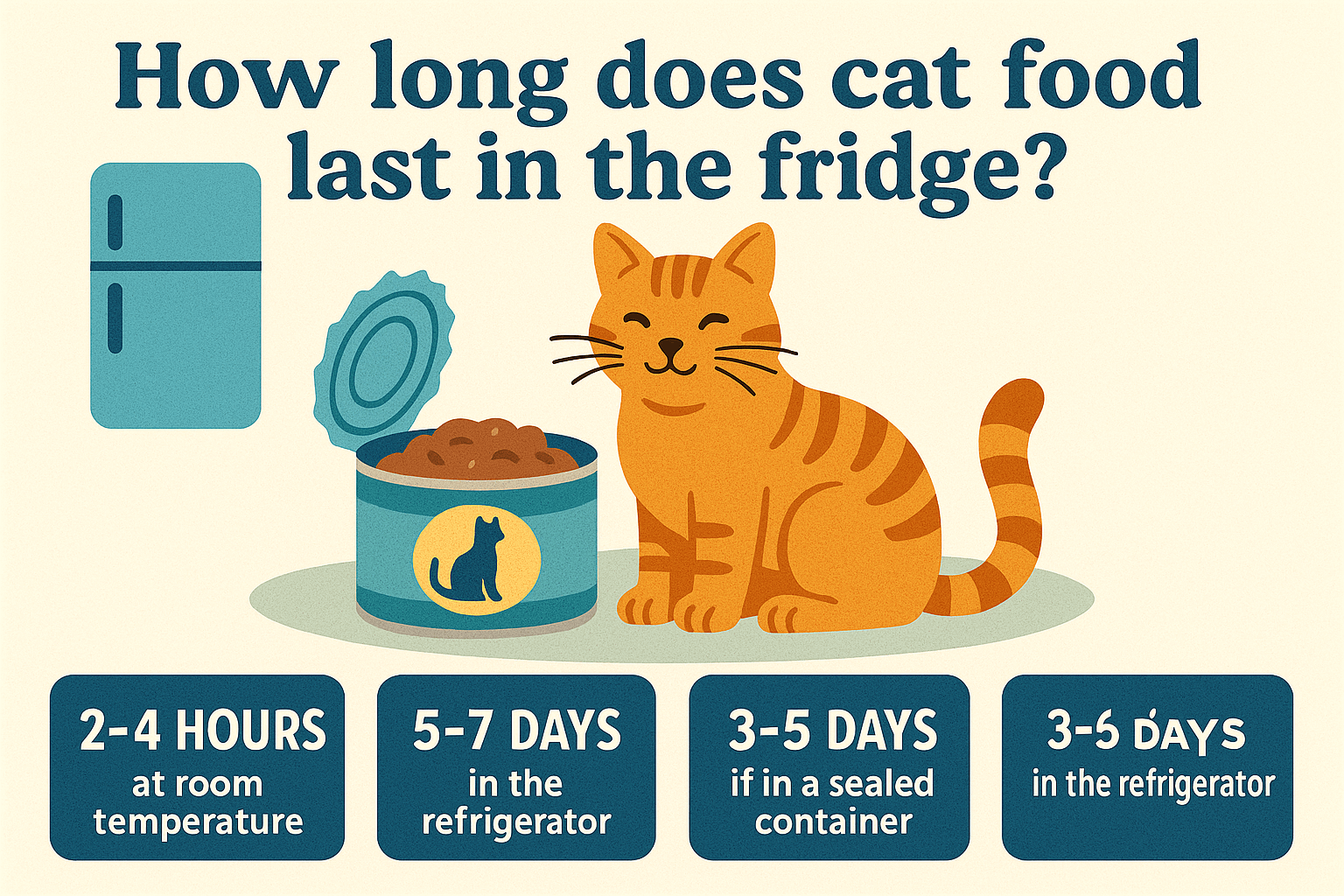How Long Does Cat Food Last in the Fridge?
As a cat owner, you may find yourself wondering how long leftover cat food can safely stay in the fridge. Whether it’s wet food, homemade meals, or even dry kibble mixed with water, proper storage is essential to ensure your feline friend stays healthy and happy. Leaving uneaten food out for too long can lead to spoilage, bacterial growth, and potential health risks for your pet. In this blog post, we’ll explore everything you need to know about storing cat food in the fridge, including shelf life, best practices, and tips for keeping your cat’s meals fresh and safe.
Expert Insight: The Benefits of Dry Cat Food
“Dry food, or kibble, is a popular choice for cat parents, as a bag can stay fresh for two to three months if properly stored. Dry food is also easier to put in puzzle toys, food dispensing toys, or automatic feeders that keep your cat engaged throughout the day.”
How Long Can Different Types of Cat Food Last in the Fridge?
The lifespan of cat food in the fridge depends on its type—wet, dry, or homemade. Understanding these differences helps you manage leftovers effectively and avoid waste.
Wet Cat Food (Canned or Pouches):
Opened wet cat food typically lasts 2-4 days in the fridge when stored in an airtight container. Always check for signs of spoilage before serving.Dry Cat Food Mixed with Water:
If you’ve moistened dry kibble, it should be consumed within 1-2 days. Dry food alone doesn’t need refrigeration but should be kept in a cool, dry place.Homemade Cat Meals:
Freshly prepared cat food, such as cooked chicken or fish, lasts up to 3-4 days in the fridge. Use shallow containers to cool it quickly after cooking.Raw Cat Food:
Raw diets require strict hygiene and should only be refrigerated for 1-2 days. Freezing portions is recommended for longer storage.Treats and Snacks:
Commercial cat treats can last up to 7 days in the fridge if unopened. Once opened, consume within 2-3 days to prevent spoilage.
By knowing the specific shelf life of each type of cat food, you can ensure your pet enjoys fresh and nutritious meals every time.

How Long Can Different Types of Cat Food Last in the Fridge?
The lifespan of cat food in the fridge depends on its type—wet, dry, or homemade. Understanding these differences helps you manage leftovers effectively and avoid waste.
Wet Cat Food (Canned or Pouches):
Opened wet cat food typically lasts 2-4 days in the fridge when stored in an airtight container. Always check for signs of spoilage before serving.Dry Cat Food Mixed with Water:
If you’ve moistened dry kibble, it should be consumed within 1-2 days. Dry food alone doesn’t need refrigeration but should be kept in a cool, dry place.Homemade Cat Meals:
Freshly prepared cat food, such as cooked chicken or fish, lasts up to 3-4 days in the fridge. Use shallow containers to cool it quickly after cooking.Raw Cat Food:
Raw diets require strict hygiene and should only be refrigerated for 1-2 days. Freezing portions is recommended for longer storage.Treats and Snacks:
Commercial cat treats can last up to 7 days in the fridge if unopened. Once opened, consume within 2-3 days to prevent spoilage.
By knowing the specific shelf life of each type of cat food, you can ensure your pet enjoys fresh and nutritious meals every time.
Check this guide 👉Top 5 Grain-Free Wet Cat Foods for Ultimate Feline Health!
Check this guide 👉Top 5 Power-Packed Senior Cat Foods for Ultimate Health!
Check this guide 👉Top 5 Automatic Cat Food Dispensers for Ultimate Control!
Type of Cat Food | Recommended Storage Time in Fridge |
|---|---|
Wet Cat Food (Opened) | 2-4 Days |
Dry Cat Food (Moistened) | 1-2 Days |
Homemade Cooked Meals | 3-4 Days |
Raw Cat Food | 1-2 Days |
Commercial Treats (Opened) | 2-3 Days |
Signs That Cat Food Has Gone Bad
Even if you store cat food properly, it’s important to recognize signs of spoilage to protect your pet’s health. Spoiled food can cause digestive upset or worse.
Unpleasant Smell:
If the food emits a sour or rancid odor, it’s likely no longer safe to serve.Visible Mold or Discoloration:
Mold growth or unusual color changes are clear indicators that the food has spoiled.Slimy Texture:
Wet food that feels unusually slimy or sticky may have developed harmful bacteria.Off Taste (If You’re Brave Enough):
While not recommended, tasting a tiny bit might reveal sourness or bitterness.Expired Date on Packaging:
Always check expiration dates, especially for unopened food, as expired items may lose nutritional value or spoil faster.
By staying vigilant for these signs, you can avoid feeding your cat anything that might harm them.
How to Make the Most of Leftover Cat Food
Leftover cat food doesn’t have to go to waste if handled correctly. Here are some creative ways to manage and repurpose uneaten portions.
Portion Control:
Serve smaller amounts to reduce leftovers. This ensures your cat eats fresh food at every meal.Freeze for Later Use:
Freeze excess wet or homemade food in portion-sized containers or ice cube trays for future use.Mix with Fresh Ingredients:
Combine older food with fresh ingredients to entice your cat and extend its usability.Donate Unused Food:
Unopened or lightly used food can be donated to local shelters or rescue organizations.Create DIY Treats:
Blend leftover wet food with dry kibble and bake it into homemade treats for your cat.
With a little creativity, you can minimize waste and make the most of your cat’s meals.
Common Mistakes to Avoid When Storing Cat Food
Storing cat food incorrectly can lead to spoilage and health risks. Avoid these common mistakes to ensure your pet’s meals stay fresh and safe.
Leaving Food Out Too Long:
Allowing food to sit at room temperature for extended periods promotes bacterial growth. Always refrigerate promptly.Using Non-Airtight Containers:
Exposure to air can dry out wet food or allow contaminants to enter. Always use sealed containers.Ignoring Expiration Dates:
Feeding expired food increases the risk of nutritional deficiencies or spoilage. Check labels carefully.Overfilling the Fridge:
Overcrowding prevents proper airflow, which can affect cooling efficiency and food safety.Not Cleaning Storage Containers Regularly:
Residue buildup in containers can harbor bacteria. Wash them thoroughly between uses.
By avoiding these errors, you can maintain the quality and safety of your cat’s food.
Benefits of Freezing Cat Food
Freezing cat food is an excellent way to extend its shelf life while preserving nutrients. Here are some benefits of freezing your cat’s meals.
Longer Shelf Life:
Freezing can extend the life of wet or homemade food by several weeks or months, depending on the type.Preservation of Nutrients:
Properly frozen food retains its nutritional value better than food left at room temperature.Convenience for Busy Owners:
Pre-portioned frozen meals save time and effort during busy days.Reduced Waste:
Freezing leftovers minimizes food waste and ensures nothing goes unused.Customizable Portions:
Freezing allows you to create tailored portions based on your cat’s dietary needs.
Freezing offers a practical solution for managing your cat’s food supply effectively.
How to Transition Your Cat to Refrigerated Food
Some cats may be hesitant to eat refrigerated food due to its cooler temperature. These tips can help ease the transition.
Warm the Food Slightly:
Heat the food to room temperature using warm water or a low microwave setting to make it more appealing.Mix with Fresh Ingredients:
Combine refrigerated food with fresh toppings like shredded chicken or tuna to entice your cat.Introduce Gradually:
Slowly incorporate refrigerated food into their diet over several days to avoid sudden changes.Experiment with Textures:
Some cats prefer softer textures, so blending refrigerated food can make it more palatable.Reward with Treats:
Offer a small treat after eating refrigerated food to create positive associations.
With patience and creativity, you can help your cat adjust to eating refrigerated meals without issue.
Frequently Asked Questions About Storing Cat Food
Can I leave wet cat food out overnight?
No, wet cat food should not be left out for more than 2 hours to prevent bacterial growth.
How do I defrost frozen cat food safely?
Thaw frozen food in the fridge overnight or use the defrost setting on your microwave, ensuring it’s heated evenly.
Is it okay to feed my cat food straight from the fridge?
Yes, but warming it slightly to room temperature may make it more appealing to your cat.
What happens if my cat eats spoiled food?
Consuming spoiled food can cause vomiting, diarrhea, or other digestive issues. Contact your vet if symptoms persist.
Can I store dry cat food in the fridge?
No, dry food should be stored in a cool, dry place, as refrigeration can introduce moisture and compromise its quality.
Ensuring Your Cat Enjoys Fresh and Safe Meals
Knowing how long cat food lasts in the fridge and how to store it properly is vital for your pet’s health and happiness. By following best practices, recognizing signs of spoilage, and minimizing waste, you can provide your cat with nutritious meals every day. Remember, a little effort goes a long way in keeping your feline friend content and thriving. With these tips in mind, you’ll never have to worry about whether your cat’s food is safe to eat again.
Can a Cat Die from a Cold? Best 7 Expert Tips! Learn how to identify, treat, and prevent feline colds while understanding when to seek veterinary care for your cat’s health.
Cat Screaming for Food: Best 7 Expert Tips! Discover effective strategies to manage your cat's food-related vocalizations and create a peaceful feeding routine.
Aspiration Pneumonia in Cats: Best 7 Expert Tips! Discover causes, symptoms, and treatment advice to protect your cat’s respiratory health and ensure a speedy recovery.
Hip Dysplasia in Cats: Best 7 Expert Tips! Discover expert advice on managing hip dysplasia in cats, from symptoms and prevention to treatment options for a happier, healthier feline life.





